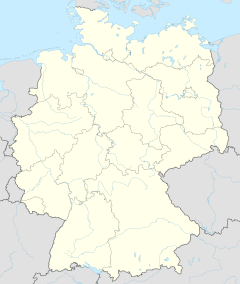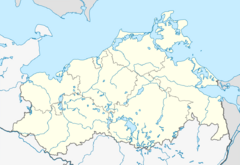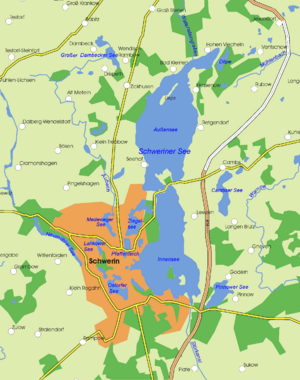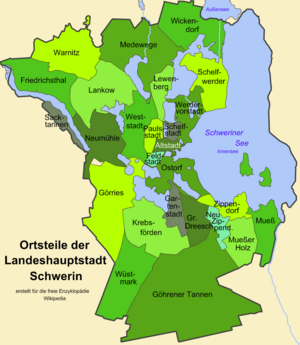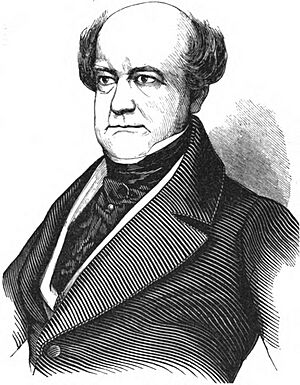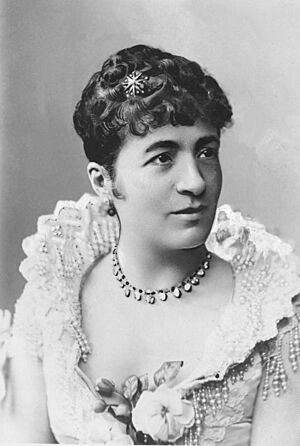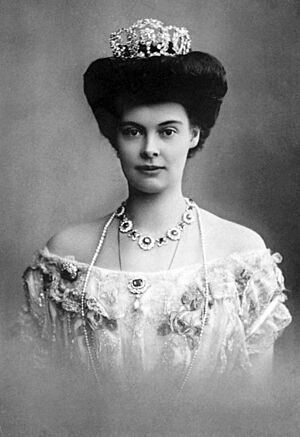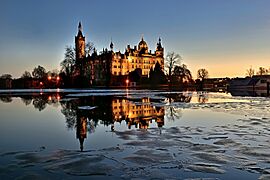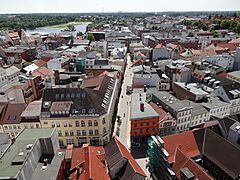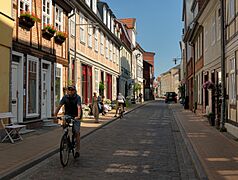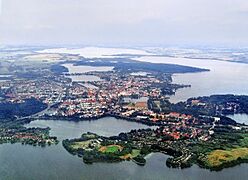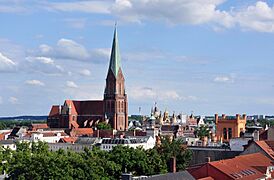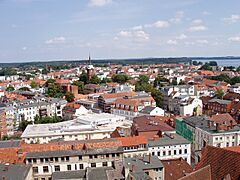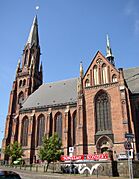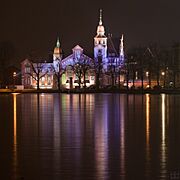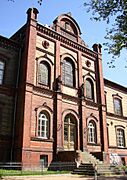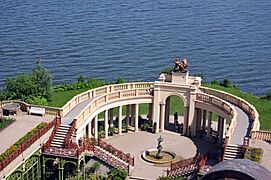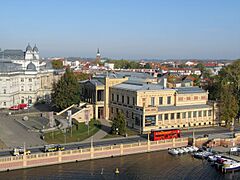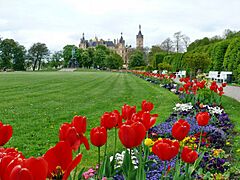Schwerin facts for kids
Quick facts for kids
Schwerin
|
|||
|---|---|---|---|
|
From top down, left to right: Schwerin Castle, Clergymen's Pond and Schwerin Cathedral, castle garden, Mecklenburg State Theater, view of Lake Schwerin from St Paul's Church, view over the city
|
|||
|
|||
| Country | Germany | ||
| State | Mecklenburg-Vorpommern | ||
| District | Urban district | ||
| Subdivisions | 18 boroughs | ||
| Area | |||
| • Total | 130.46 km2 (50.37 sq mi) | ||
| Elevation | 38 m (125 ft) | ||
| Population
(2022-12-31)
|
|||
| • Total | 98,596 | ||
| • Density | 755.76/km2 (1,957.40/sq mi) | ||
| Time zone | UTC+01:00 (CET) | ||
| • Summer (DST) | UTC+02:00 (CEST) | ||
| Postal codes |
19053, 19055, 19057, 19059, 19061, 19063
|
||
| Dialling codes | 0385 | ||
| Vehicle registration | SN | ||
| Website | schwerin.de | ||
Schwerin is the capital city of the German state of Mecklenburg-Vorpommern. It is the second-largest city in this state, after Rostock. Around 96,000 people live in Schwerin. This makes it the smallest state capital in Germany.
Schwerin is located on the southwest side of Lake Schwerin. This is the second-largest lake in the Mecklenburg Lake Plateau. There are also eleven other lakes right inside the city. The city's name comes from a Slavic word. It means "wild animal" or "game reserve."
Schwerin was first mentioned in the year 1018. It became a city in 1160. This makes it the oldest city in Mecklenburg-Vorpommern. For many years, Schwerin was the main home of the House of Mecklenburg. This was a powerful family with Slavic roots. They ruled as dukes and grand dukes.
The beautiful Schwerin Palace is a famous landmark. It sits on Castle Island, between Lake Schwerin and Castle Lake. The palace used to be where the dukes lived. Today, it is the home of the state parliament. Other important buildings are Schwerin Cathedral, St Paul's Church, and St Nicholas' Church. The city was not badly damaged in World War II. Because of this, many old buildings are still standing.
Schwerin has important industries. These include high technology, machine building, and healthcare. It also has government offices and tourism. The city has two colleges. There is a regional airport nearby in Parchim. The main airport for the city is Hamburg Airport.
Contents
History of Schwerin
Early Times
Schwerin is surrounded by many lakes. The biggest one is Lake Schwerin, which is very large. Long ago, in the 11th century, a Slavic group called the Obotrites lived here. Their settlement was called Zuarin. The name Schwerin comes from this old name.
In 1160, a powerful leader named Henry the Lion took over the area. He defeated the Obotrites and captured Schwerin. The town then grew into an important regional center. A castle was built here. It later became the grand ducal palace. People say a small ghost, called Petermännchen, lives in the castle.
In 1358, Schwerin became part of the Duchy of Mecklenburg. From then on, it was the capital of the duchy. Around 1500, work began on the Schwerin Palace. This was to be the home for the dukes. After Mecklenburg was divided in 1621, Schwerin became the capital of Mecklenburg-Schwerin. For a short time, from 1765 to 1837, the capital moved to Ludwigslust. But then Schwerin became the capital again.
Recent Times
In the mid-1800s, many people from Schwerin moved to the United States. A lot of them went to Milwaukee, Wisconsin. Today, Milwaukee and Schwerin are sister cities. After 1918, Germany had a revolution. All the royal families lost their power. The Grand Duke of Mecklenburg also stepped down. Schwerin then became the capital of the Free State of Mecklenburg-Schwerin.
During World War II, Schwerin was bombed a few times. At the end of the war, in May 1945, American troops took over Schwerin. It was then given to the British. A month later, it was handed over to Soviet forces. This happened as the British and American troops moved to their agreed-upon zones.
Schwerin was then in the Soviet Occupation Zone. This area later became East Germany. At first, Schwerin was the capital of the state of Mecklenburg. In 1952, the states in East Germany were changed. Schwerin then became the capital of the Schwerin district.
After Germany reunited in 1990, the state of Mecklenburg-Vorpommern was created again. Rostock also wanted to be the state capital. But the decision was made to choose Schwerin.
Population
| Historical population | ||
|---|---|---|
| Year | Pop. | ±% |
| 1500 | 2,500 | — |
| 1790 | 3,512 | +40.5% |
| 1819 | 5,854 | +66.7% |
| 1840 | 16,648 | +184.4% |
| 1860 | 23,517 | +41.3% |
| 1880 | 30,146 | +28.2% |
| 1900 | 38,667 | +28.3% |
| 1910 | 42,519 | +10.0% |
| 1925 | 48,157 | +13.3% |
| 1933 | 53,621 | +11.3% |
| 1940 | 67,200 | +25.3% |
| 1950 | 93,576 | +39.3% |
| 1961 | 92,902 | −0.7% |
| 1966 | 92,356 | −0.6% |
| 1971 | 100,888 | +9.2% |
| 1976 | 110,051 | +9.1% |
| 1981 | 122,264 | +11.1% |
| 1986 | 128,328 | +5.0% |
| 1991 | 125,959 | −1.8% |
| 1996 | 111,029 | −11.9% |
| 2001 | 99,978 | −10.0% |
| 2006 | 96,280 | −3.7% |
| 2011 | 95,300 | −1.0% |
| 2016 | 96,558 | +1.3% |
| 2021 | 95,740 | −0.8% |
| Population size may be affected by changes in administrative divisions. | ||
Schwerin has about 95,000 people living there. It is the smallest state capital in Germany. During the time of East Germany, Schwerin was known for its leather factories. In 1991, Schwerin became the capital of the state. At that time, it had 126,000 people.
After Germany reunited, Schwerin's population started to get smaller. It fell below 100,000 people in the year 2000. This meant it lost its official title as a "major city." Schwerin is also the only state capital that does not have a university.
Geography of Schwerin
Lakes in Schwerin
There are 12 lakes within Schwerin's city limits. Here are some of them and their size in square kilometers:
- Lake Schwerin (Schweriner See) 61.5 km²
- Brick Lake (Ziegelsee) 3.0 km²
- Lake Ostorf (Ostorfer See) 2.1 km²
- New Mill Lake (Neumühler See) 1.7 km²
- Lake Medewege (Medeweger See) 1.0 km²
- Lake Lankow (Lankower See) 0.5 km²
- Clergymen's Pond (Pfaffenteich) 0.1 km²
- Castle Lake (Burgsee) 0.1 km²
Islands in Schwerin
- Rabbit Ait (Kaninchenwerder) in Lake Schwerin
- Brick Ait (Ziegelwerder) in Lake Schwerin
- Castle Island (Schlossinsel) between Lake Schwerin and Castle Lake
Boroughs of Schwerin
Schwerin is divided into 17 main local districts. These districts have smaller areas called boroughs. There are 26 boroughs in total. Some of the boroughs include:
- Schelfstadt, Werdervorstadt, Schelfwerder
- Altstadt (Old Town), Feldstadt, Paulsstadt, Lewenberg
- Großer Dreesch
- Neu Zippendorf
- Mueßer Holz
- Lankow
- Weststadt
- Krebsförden
- Friedrichsthal
- Neumühle, Sacktannen
- Warnitz
- Wickendorf, Medewege
- Zippendorf
- Mueß
Schwerin shares borders with several nearby towns. These include Klein Trebbow, Seehof, Leezen, Raben Steinfeld, Plate, Banzkow, Lübesse, Holthusen, Pampow, Klein Rogahn, Wittenförden, Brüsewitz, and Pingelshagen.
Climate
| Climate data for Schwerin (1991–2020 normals) | |||||||||||||
|---|---|---|---|---|---|---|---|---|---|---|---|---|---|
| Month | Jan | Feb | Mar | Apr | May | Jun | Jul | Aug | Sep | Oct | Nov | Dec | Year |
| Record high °C (°F) | 14.7 (58.5) |
18.3 (64.9) |
23.5 (74.3) |
29.3 (84.7) |
35.7 (96.3) |
35.1 (95.2) |
38.4 (101.1) |
37.8 (100.0) |
32.9 (91.2) |
26.8 (80.2) |
19.7 (67.5) |
15.2 (59.4) |
38.4 (101.1) |
| Mean daily maximum °C (°F) | 3.3 (37.9) |
4.4 (39.9) |
8.2 (46.8) |
13.8 (56.8) |
18.1 (64.6) |
21.0 (69.8) |
23.3 (73.9) |
23.1 (73.6) |
18.8 (65.8) |
13.2 (55.8) |
7.5 (45.5) |
4.2 (39.6) |
13.2 (55.8) |
| Daily mean °C (°F) | 1.2 (34.2) |
1.8 (35.2) |
4.4 (39.9) |
9.0 (48.2) |
13.1 (55.6) |
16.2 (61.2) |
18.4 (65.1) |
18.1 (64.6) |
14.3 (57.7) |
9.7 (49.5) |
5.2 (41.4) |
2.2 (36.0) |
9.5 (49.1) |
| Mean daily minimum °C (°F) | −1.1 (30.0) |
−0.9 (30.4) |
1.1 (34.0) |
4.4 (39.9) |
8.1 (46.6) |
11.4 (52.5) |
13.8 (56.8) |
13.7 (56.7) |
10.6 (51.1) |
6.6 (43.9) |
2.9 (37.2) |
0.1 (32.2) |
5.9 (42.6) |
| Record low °C (°F) | −22.2 (−8.0) |
−27.0 (−16.6) |
−17.7 (0.1) |
−7.4 (18.7) |
−2.5 (27.5) |
1.1 (34.0) |
5.6 (42.1) |
4.9 (40.8) |
0.1 (32.2) |
−4.5 (23.9) |
−11.7 (10.9) |
−20.9 (−5.6) |
−27.0 (−16.6) |
| Average precipitation mm (inches) | 55.6 (2.19) |
42.4 (1.67) |
44.0 (1.73) |
35.1 (1.38) |
46.7 (1.84) |
59.0 (2.32) |
75.4 (2.97) |
67.2 (2.65) |
52.2 (2.06) |
51.0 (2.01) |
48.3 (1.90) |
56.5 (2.22) |
628.5 (24.74) |
| Average precipitation days (≥ 1.0 mm) | 17.4 | 15.1 | 14.5 | 11.8 | 13.1 | 13.6 | 15.2 | 14.8 | 13.6 | 14.7 | 16.3 | 17.7 | 176.9 |
| Average snowy days (≥ 1.0 cm) | 7.7 | 7.6 | 3.4 | 0.2 | 0 | 0 | 0 | 0 | 0 | 0 | 1.3 | 3.7 | 23.9 |
| Average relative humidity (%) | 87.0 | 83.4 | 78.4 | 71.0 | 70.8 | 71.8 | 72.8 | 74.0 | 78.8 | 84.1 | 88.4 | 88.8 | 79.1 |
| Mean monthly sunshine hours | 44.5 | 63.6 | 128.5 | 190.6 | 236.3 | 229.4 | 227.4 | 207.2 | 157.3 | 106.2 | 49.8 | 35.0 | 1,661 |
| Source 1: World Meteorological Organization | |||||||||||||
| Source 2: Infoclimat | |||||||||||||
Getting Around Schwerin
City buses and trams in Schwerin are managed by NVS (Nahverkehr Schwerin).
The main train station, Schwerin Hauptbahnhof, connects the city by rail. You can travel to Berlin, Hamburg, and Rostock from here.
Main Sights to See
- The most famous building is the Schwerin Palace. It is on an island in Lake Schwerin. For hundreds of years, it was the home of the Dukes of Mecklenburg. Now, it is where the state parliament meets.
- Schwerin Cathedral was built between 1260 and 1416. It is made in a style called Brick Gothic.
- The Alter Garten (Old Garden) is a large square. It is surrounded by important buildings. These include the 18th-century Altes Palais (Old Palace). There is also the State Art Museum, built from 1877 to 1882. The Staatstheater (City Theater) was built in 1886.
- The city hall was built in the 18th century.
- Schelfkirche (Saint Nicolai Church) was first built in 1238. It was rebuilt in 1713 after a storm damaged it.
- The TV Tower Schwerin-Zippendorf is a tall landmark.
Museums to Visit
- The State Art Museum has many amazing artworks. It has Dutch paintings from the 1600s. There is also German art from the Middle Ages to today. You can see Greek vases and sculptures here too.
- The State Museum of Technology used to be in Schwerin. It was in the old royal stables. In 2012, this museum moved to the city of Wismar.
Sister Cities
Schwerin is connected with other cities around the world. These are called "twin towns" or "sister cities." They often share cultural events and ideas.
Famous People from Schwerin
Many interesting people were born or lived in Schwerin. Here are a few:
- Konrad Ernst Ackermann (1712–1771), an actor.
- Friedrich Ludwig Schröder (1744–1816), an actor and writer for the theater.
- Heinrich von Bülow (1792–1846), a diplomat and statesman.
- August Kundt (1839–1894), a physicist who invented the Kundt's tube.
- Walther Flemming (1843–1905), a biologist who founded the study of cytogenetics.
- Marie Hankel (1844–1929), a writer and supporter of women's suffrage.
- Franziska Ellmenreich (1847–1931), a famous actress.
- Ludwig Bölkow (1912–2003), an industrialist and pioneer in aviation.
- Gudrun Zapf-von Hesse (1918–2019), a typographer and bookbinder.
- Katrin Sass (born 1956), an actress.
- Oliver Riedel (born 1971), a musician and member of the band Rammstein.
Royalty and Nobles
- Albert II, Duke of Mecklenburg (around 1318–1379), a feudal lord.
- Sophia Louise of Mecklenburg-Schwerin (1685–1735), who became Queen of Prussia.
- Frederick Francis I (1756–1837), a ruler as duke and grand duke.
- Duchess Louise Charlotte of Mecklenburg-Schwerin (1779–1801), grandmother of Prince Albert. He was the husband of Queen Victoria.
- Duchess Cecilie of Mecklenburg-Schwerin (1886–1954), the last Crown Princess of the German Empire.
Sports Stars
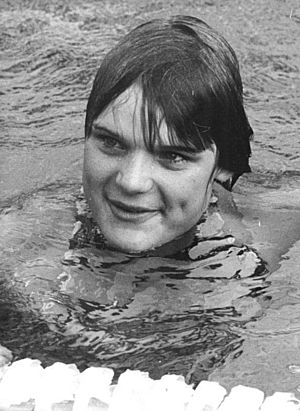
- Manfred Schneider (born 1941), a rower who won a bronze medal at the 1972 Summer Olympics.
- Gabriele Hinzmann (born 1947), a discus thrower who won a bronze medal at the 1976 Summer Olympics.
- Rosemarie Gabriel (born 1956), a swimmer who won gold and silver medals at the 1976 Summer Olympics.
- Andrea Pollack (born 1961), a swimmer who won many medals at the 1976 and 1980 Summer Olympics.
- Torsten Bréchôt (born 1964), a judoka who won a bronze medal at the 1988 Summer Olympics.
- Peter Kretschmer (born 1992), a sprint canoer who won a gold medal at the 2012 Summer Olympics.
Gallery
See also
 In Spanish: Schwerin para niños
In Spanish: Schwerin para niños










